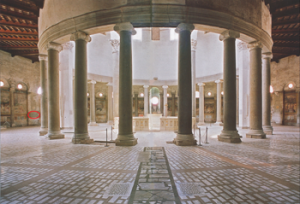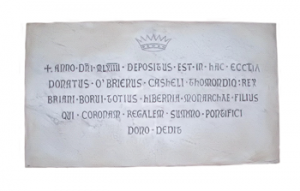See Rome and die: the burial-place of Donnchad mac Briain
Published in Features, Issue 2 (March/April 2014), Volume 22
The basilica of Santo Stefano Rotondo on the Coelian Hill, one of the great early Christian churches of Rome, built in the fifth century to house the relics of St Stephen.
When Brian Boru was killed at the Battle of Clontarf he left two sons chall-enging each other for the succession, half-brothers of whom the older was Donnchad, son of the famous Gormlaith (d. 1030). There followed a type of civil war within Dál Cais, culminating in 1023 in the treacherous killing of the younger brother, Tadc, at Donnchad’s instigation.
From this point Donnchad mac Briain sought to recover his father’s position of greatness, and by the end of the 1020s many of the other provincial kings had acknowledged him as their superior. Hence, when he commissioned an ornamental shrine for the Stowe (or Lorrha) Missal, the inscription depicts him as RIG HEREND (‘king of Ireland’). But it was a shallow boast: although successful at enforcing his authority over the southern half of Ireland, he never gained hegemony over the north and his fortunes gradually began to dip.
Donnchad faced growing opposition from the Leinster king Diarmait mac Máel na mBó (ancestor of Dermot MacMurrough), foster-father to Tairdelbach ua Briain, son of the murdered Tadc. Together they made war on Donnchad, year after year invading his territory until, in 1063, the old king finally submitted to his nephew and abandoned his kingship.
One might have expected a man of Donnchad’s years to live out his few remaining days in an Irish monastery in serene preparation for meeting his Maker, but Donnchad had other plans. In 1064, while certainly in his early eighties, he set off for Rome. He didn’t travel alone. In 1032 Donnchad had married the daughter of a Hiberno-Norse king called Ragnall, and her brother was probably the Echmarcach mac Ragnaill who shortly afterwards ejected Sitric Silkenbeard from the kingship of Dublin. At various points Echmarcach attempted to rule Dublin, Man, the Western Isles and the Rhinns of Galloway, until he eventually lost all his possessions at around the time of Donnchad’s abdication. Therefore, when Donnchad decided to travel to Rome, Echmarcach went with him.

The plaque referring to Donnchad mac Briain, son of Brian Boru.
Such a trip to Rome was on the ‘bucket-list’ of all eleventh-century notables who had the resources and stamina to contemplate it, and we know the names of at least seven other Irish or Hiberno-Norse kings who travelled to Rome in the generation before Donnchad and Echmarcach. Of course, Rome was an arduous and dangerous journey away and, for all its splendour, was so notoriously hard on visitors—who succumbed in droves to its summer heat and malaria—that those setting out knew they stood a good chance of not returning. This must have been all the more apparent to a man of Donnchad mac Briain’s age. Therefore he surely knew his pilgrimage to Rome would be a permanent exile.
Tradition has it—at least as recorded by Conall Mac Eochagáin in his seventeenth-century translation of the Annals of Clonmacnoise—that Donnchad
‘brought the Crowen of Ireland with him thither, which remained with the Popes until Pope Adrian gave the same to King Henry the second that conquered Ireland. Donnogh mc Briain died in pilgrimage in the abby of St Stephen the Protomartyre.’
This idea that the basis for the English claim to Ireland lay in a crown brought by Donnchad to Rome and then bestowed by the pope on Henry II is presumably baseless; that said, in 1186 Pope Urban III did indeed send a crown, made of gold-embroidered peacocks’ feathers, to Henry II, intended for his son John’s coronation as king of Ireland, although no such coronation ever took place.
And the Annals of Clonmacnoise are not the only source for this statement. The basilica of Santo Stefano Rotondo on the Coelian Hill is one of the great early Christian churches of Rome, built in the fifth century to house the relics of St Stephen. It was an important place of pilgrimage and had lodgings for travellers, and it appears that Donnchad and his brother-in-law Echmarcach stayed there, although within months both men had died (their deaths being recorded in separate entries in several Irish annals). Prominently located on a wall inside this splendid basilica, a plaque records Donnchad’s death and also his supposed bestowal of the crown of Ireland on the pope. In translation it reads:
‘In the year of Our Lord 1064, Donatus O’Brienus, King of Cashel and Thomond, son of Brian Boru, Monarch of All Ireland, gave the royal crown as a gift to the Pope’.
It is not known when or by whom the plaque was erected, and the author would welcome any assistance readers can offer. It is certainly several centuries old (is it a coincidence that the Irish College is located at the other end of the same road, the Via di Santo Stefano Rotondo?)—and is a unique memorial to an exiled Irish high-king.
Seán Duffy lectures in medieval history at Trinity College, Dublin.
















